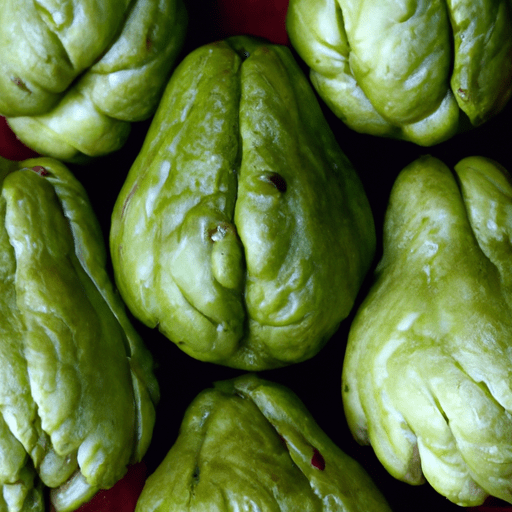The Versatile Chayote Squash: A Hidden Gem in the Culinary World
If you’ve ever explored the hidden corners of the produce section, you might have come across the intriguing chayote squash. This humble vegetable, also known as mirliton or vegetable pear, may not be as popular as some of its counterparts, but it possesses a delightful flavor and brings a unique twist to a variety of dishes. In this blog post, we will delve deeper into the world of chayote squash, exploring its taste, common culinary uses, nutritional benefits, and fascinating history.
A Taste of Chayote Squash
With its pale green color and pear-shaped appearance, chayote squash is often mistaken for a fruit. However, once you sink your teeth into it, you’ll discover its true savory nature. Chayote has a subtle, mild flavor with hints of cucumber and a touch of crispness. This refreshing taste makes it an excellent addition to both raw and cooked dishes, adding a burst of freshness and texture.
Common Uses in Cooking
One of the standout qualities of chayote squash is its incredible versatility in the kitchen. From salads to stews, this vegetable can be used in numerous ways, adding a unique twist to various cuisines. Some popular cooking methods include:
1. Raw in Salads and Slaws
Sliced or grated, chayote squash makes a fabulous addition to salads and slaws. Its crisp texture stands up well to dressings, and its subtle flavor allows it to blend harmoniously with other ingredients. Combine it with crisp lettuce, juicy tomatoes, and a zesty vinaigrette for a refreshing side dish.
2. Stir-Fried or Sauteed
Chayote squash takes beautifully to high heat cooking methods like stir-frying or sautéing. Cut it into thin strips or cubes and toss it into a hot pan with your choice of oil, garlic, and spices. The stir-fried chayote becomes tender with a slight crunch, retaining its vibrant green color and delicate flavor.
3. Stuffed and Baked
For a delightful centerpiece dish, chayote squash can be stuffed and baked to perfection. Hollow out the squash, fill it with a savory mixture of your choice, such as seasoned ground meat, cheese, or grains, and bake until the flavors meld together. The result is a tender, melt-in-your-mouth treat that is sure to impress.
4. Soups and Stews
Chayote squash is a fantastic ingredient to incorporate into soups and stews. Its mild flavor allows it to absorb the richness of broths and adds a delightful texture to the dish. Chop it into chunks and simmer it alongside other vegetables, meats, or legumes for a comforting and nourishing meal.
Nutritional Value
In addition to its culinary potential, chayote squash is also a nutritional powerhouse. This vegetable is low in calories and high in fiber, making it an excellent choice for those seeking a healthy and balanced diet. Chayote squash also contains essential vitamins and minerals such as Vitamin C, Vitamin B6, folate, and potassium. Its high water content contributes to hydration, while its fiber content supports digestive health.
History and Interesting Facts
Chayote squash has a rich history that spans across different cultures and continents. Native to Mesoamerica, this vegetable has been cultivated for thousands of years. It was introduced to Europe during the colonization of the Americas and quickly gained popularity for its versatility and taste. Today, chayote squash is widely consumed in Latin American, Caribbean, and Asian cuisines, adding a distinctive twist to traditional dishes.
Interestingly, chayote squash is not only cherished for its culinary applications but also for its medicinal properties. It has been used in traditional medicine to alleviate digestive issues and promote overall well-being.
Conclusion
From its subtle flavor to its versatility in the kitchen, chayote squash is a true hidden gem waiting to be explored. With its refreshing taste, variety of culinary uses, and impressive nutritional profile, this unique vegetable deserves a place on your plate. Whether you choose to incorporate it raw in salads, stir-fry it, or experiment with stuffing and baking, chayote squash is sure to delight your taste buds and bring a touch of novelty to your cooking ventures. So, next time you come across this fascinating vegetable at your local market, be sure to grab a few and embark on a culinary adventure that celebrates the wonders of the chayote squash.
Chayote Squash
Origin: Chayote squash, also known as vegetable pear, is native to Central America and Mexico. It has been cultivated for thousands of years, with evidence of its consumption dating back to pre-Columbian times.
Common Uses: The chayote squash is an extremely versatile ingredient and is used in various culinary applications. It can be enjoyed raw in salads, pickled, stir-fried, sautéed, or even baked. The flesh of the chayote squash is mild and slightly sweet, similar to a cross between a cucumber and a pear.
Nutritional Benefits: Chayote squash is considered a healthy addition to meals due to its beneficial nutritional profile. It is low in calories, fat, and sodium and is a good source of dietary fiber. The squash also provides vitamin C, vitamin B6, potassium, and folate, among other essential nutrients.
Unique Properties: One unique aspect of the chayote squash is its seed. Unlike many other squash varieties, the chayote squash has a soft, edible seed. The entire fruit, including the skin and seed, can be consumed. The texture of the chayote squash is crisp when raw and becomes tender when cooked.
Historical Significance: Chayote squash has historical significance in many cultures. For example, it has been an essential ingredient in Mexican cuisine for centuries and is used in dishes like stews, soups, and salads. It is also widely used in parts of Asia, including the Philippines, where it is a popular vegetable in various traditional recipes.
These facts provide a brief overview of the origin, common uses, nutritional benefits, unique properties, and historical significance of chayote squash.




Use the share button below if you liked it.
It makes me smile, when I see it.